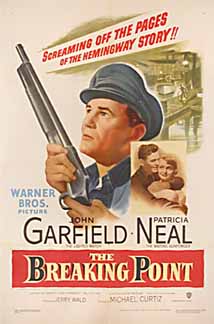
To Have and Have Not is a novel by Ernest Hemingway published in 1937 by Charles Scribner's Sons. The book follows Harry Morgan, a fishing boat captain out of Key West, Florida. To Have and Have Not was Hemingway's second novel set in the United States, after The Torrents of Spring.

Tortilla Flat is a 1942 American romantic comedy film directed by Victor Fleming and starring Spencer Tracy, Hedy Lamarr, John Garfield, Frank Morgan, Akim Tamiroff and Sheldon Leonard, based on the 1935 novel of the same name by John Steinbeck. Frank Morgan received an Academy Award nomination for Best Supporting Actor for his poignant portrayal of The Pirate.
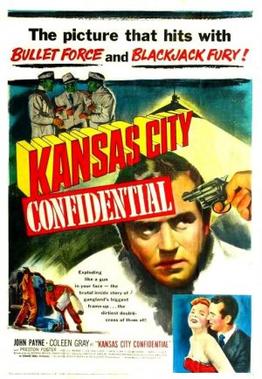
Kansas City Confidential is a 1952 American film noir and crime film directed by Phil Karlson starring John Payne and Coleen Gray. The film was released in the United Kingdom as The Secret Four. Karlson and Payne teamed a year later for 99 River Street, another film noir, followed by Hell's Island, a film noir in color.
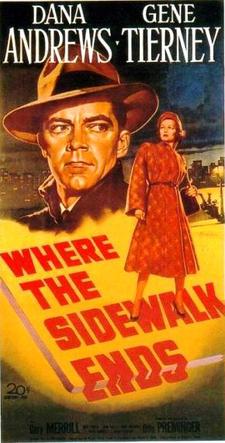
Where the Sidewalk Ends is a 1950 American film noir directed and produced by Otto Preminger. The screenplay for the film was written by Ben Hecht, and adapted by Robert E. Kent, Frank P. Rosenberg, and Victor Trivas. The screenplay and adaptations were based on the novel Night Cry by William L. Stuart. The film stars Dana Andrews and Gene Tierney.
To Have and Have Not is a 1944 American romantic war adventure film directed by Howard Hawks, loosely based on Ernest Hemingway's 1937 novel of the same name. It stars Humphrey Bogart, Walter Brennan and Lauren Bacall; it also features Dolores Moran, Hoagy Carmichael, Sheldon Leonard, Dan Seymour, and Marcel Dalio. The plot, centered on the romance between a freelancing fisherman in Martinique and a beautiful American drifter, is complicated by the growing French resistance in Vichy France.

The Big Clock is a 1948 American thriller directed by John Farrow and adapted by novelist-screenwriter Jonathan Latimer from the 1946 novel of the same title by Kenneth Fearing.
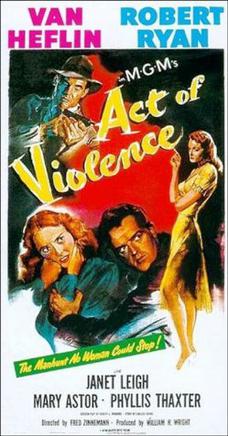
Act of Violence is a 1949 American film noir starring Van Heflin, Robert Ryan and featuring Janet Leigh, Mary Astor and Phyllis Thaxter.

Scandal Sheet is a 1952 American film noir directed by Phil Karlson. The film is based on the novel The Dark Page by Samuel Fuller, who himself was a newspaper reporter before his career in film. The drama features Broderick Crawford, Donna Reed and John Derek.

Juano G. Hernández was a Puerto Rican stage and film actor who was a pioneer in the African American film industry. He made his silent picture debut in The Life of General Villa, and talking picture debut in an Oscar Micheaux film, The Girl from Chicago, which was directed at black audiences. Hernández also performed in a series of dramatic roles in mainstream Hollywood movies. His participation in the film Intruder in the Dust (1949) earned him a Golden Globe Award nomination for "New Star of the Year." Later in life he returned to Puerto Rico, where he intended to make a film based on the life of Sixto Escobar.
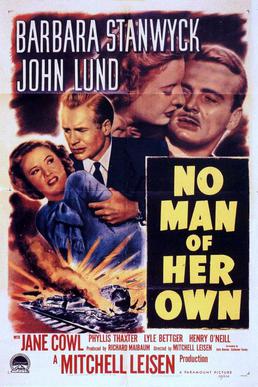
No Man of Her Own is a 1950 American film noir drama directed by Mitchell Leisen and featuring Barbara Stanwyck, John Lund, Phyllis Thaxter, Jane Cowl and Lyle Bettger. Made and distributed by Paramount Pictures, the production is the second film Stanwyck made with director Mitchell Leisen. Its screenplay was adapted from Cornell Woolrich's 1948 novel I Married a Dead Man. Woolrich is cited in the film's opening credits by one of his commonly used pseudonyms, "William Irish".

Jigsaw is a 1949 American film noir crime drama directed by Fletcher Markle starring Franchot Tone, Jean Wallace and Marc Lawrence. The feature was produced by the Danziger Brothers, Edward J. Danziger and Harry Lee Danziger, from a screenplay by Vincent McConnor and Fletcher Markle, based on a story by John Roeburt.

The Snows of Kilimanjaro is a 1952 American Technicolor romantic adventure film directed by Henry King from a screenplay by Casey Robinson, based on the 1936 short story of the same name by Ernest Hemingway. It stars Gregory Peck as Harry Street, Susan Hayward as Helen, and Ava Gardner as Cynthia Green. The film's ending does not mirror that of the short story.
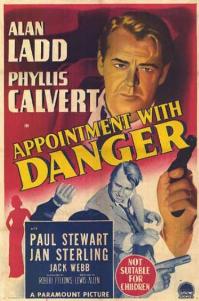
Appointment with Danger is a 1950 American crime film noir starring Alan Ladd and Phyllis Calvert, supported by Paul Stewart, Jan Sterling, and Jack Webb. Produced and distributed by Paramount Pictures, the drama was directed by Lewis Allen and written by Richard L. Breen and Warren Duff.

The Gun Runners is a 1958 American film noir crime film directed by Don Siegel, is the third adaptation of Ernest Hemingway's 1937 novel To Have and Have Not, and starring Audie Murphy. Everett Sloane essays the part of the alcoholic sidekick originally played by Walter Brennan in the film's first adaptation, although Sloane's interpretation is less overtly comic. Eddie Albert delivers a bravura performance as a charismatic villain; other cast members include Jack Elam and Richard Jaeckel. Gita Hall, "Miss Stockholm of 1953", made her Hollywood film debut as Albert's girlfriend Eva.
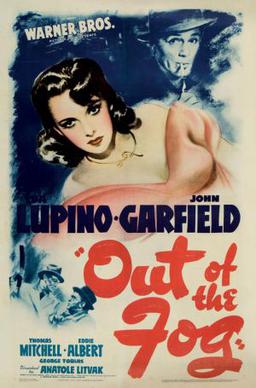
Out of the Fog is a 1941 American film noir crime drama directed by Anatole Litvak and starring John Garfield, Ida Lupino and Thomas Mitchell. The film was based on the play The Gentle People by Irwin Shaw. It was made and released by Warner Brothers.

The Sign of the Ram is a 1948 American film noir directed by John Sturges and screenplay by Charles Bennett, based on a novel written by Margaret Ferguson. The drama features Susan Peters, Alexander Knox and Phyllis Thaxter. It also featured Ron Randell. The film's title alludes to people born under the astrological sign Aries, who are supposedly strong-willed and desire to be admired, as explained in the dialogue.

Violent Saturday is a 1955 American CinemaScope crime film directed by Richard Fleischer and starring Victor Mature, Richard Egan and Stephen McNally. Set in a fictional mining town in Arizona, the film depicts the planning of a bank robbery as the nexus in the personal lives of several townspeople. Filmed on location in Bisbee, Arizona, the supporting cast was particularly strong, with Lee Marvin, Sylvia Sidney, and Ernest Borgnine.

A Gentleman After Dark is a 1942 crime/drama film starring Brian Donlevy and Miriam Hopkins.
Dear Heart is a 1964 American romantic-comedy film starring Glenn Ford and Geraldine Page as lonely middle-aged people who fall in love at a hotel convention. It was directed by Delbert Mann, from a screenplay by Tad Mosel. Its theme song "Dear Heart" was nominated for the Academy Award for Best Original Song.

John Loves Mary is a 1949 comedy film directed by David Butler and written by Henry Ephron and Phoebe Ephron. The film stars Ronald Reagan, Patricia Neal and Jack Carson. The film was released by Warner Bros. on February 19, 1949. It's based on a Broadway play of the same name written by Norman Krasna, which ran from February 4, 1947, to February 7, 1948, at the Booth Theatre and Music Box Theatre in New York City.
